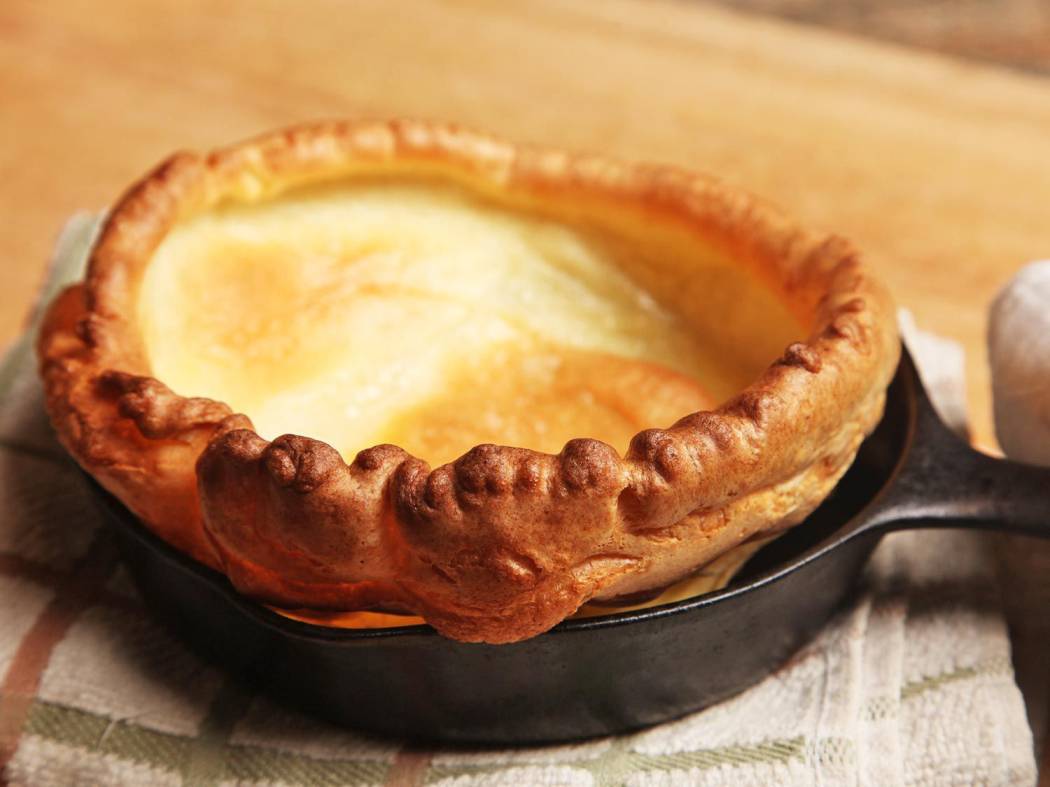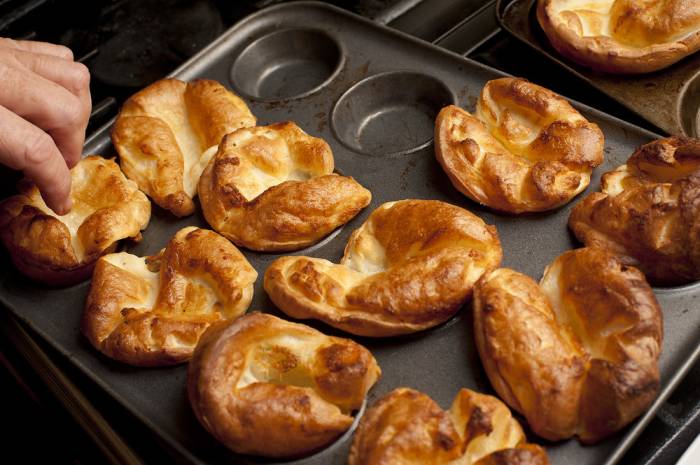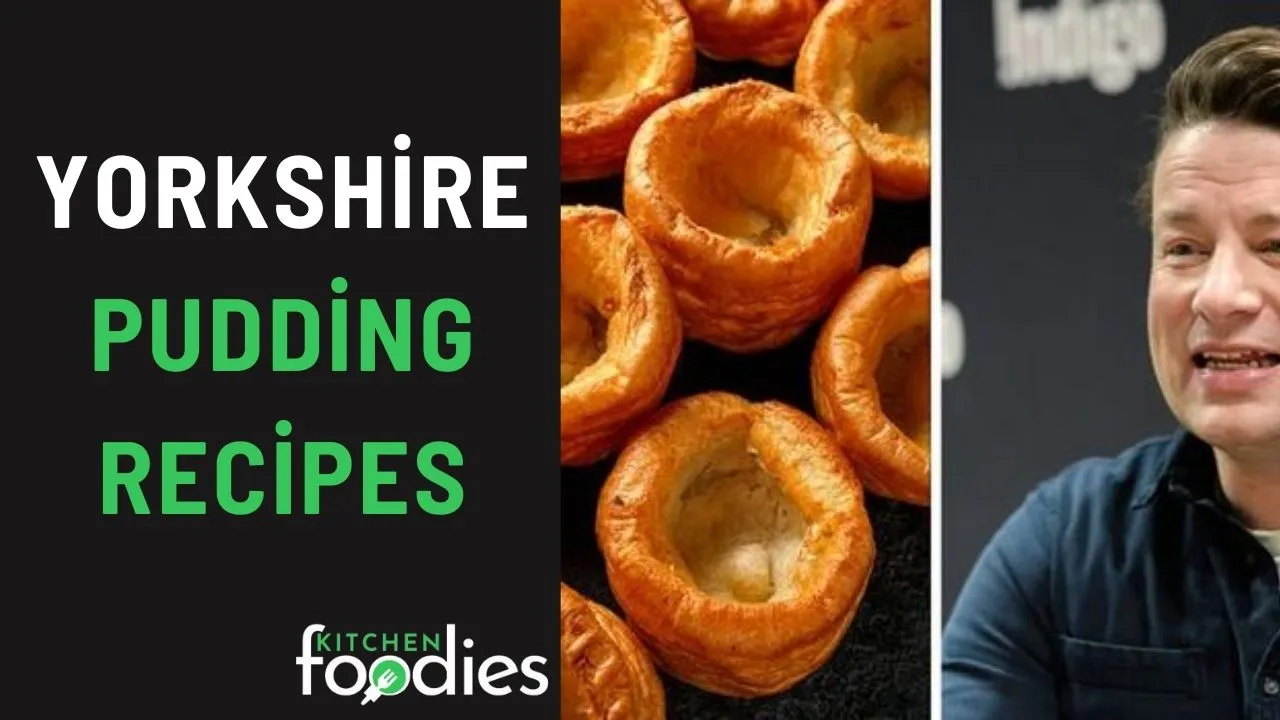If you want to make your yorkshire pudding recipe, you can use one extra egg white in the batter.
Rising tall and with a crisp shell, a delicate and gently chewy Yorkshire pudding is.
Toad-in-the-hole, the traditional British dish of sausages cooked into a big yorkshire pudding recipe, was requested by a few exchange students from Cambridge University back when I was making my pay as a cook at a co-ed fraternity house. Just issue? A Yorkshire pudding was nothing to me. Rather than, say, conducting some real research, I chose to wing it; it was explained to me as "sort of like a batter and you pour it into a pan and you bake it."
- Ranch Style Beans: What Are Ranch Style Beans?
- Boursin Cheese Pasta With Tomatoes: Ingredients And Instructions
- Pasta with Shrimp and Broccoli
Pudding, I considered myself. That should be rich and moist, sort of spoonable, like custard?

I came up with basically that: sausages baked into a large pool of eggy custard, their tops just peeping through the surface like a construction worker dropped into a vat of half-set concrete. (And the meal seemed to weigh exactly as much.)
Cooking for a fraternity house is one benefit since college students would eat anything. Still, I dug a little more at the behest of the British students and found that yorkshire pudding recipe is essentially nothing more than the British variation of the popovers my mother likes. Though technically they're somewhat similar, our popovers are baked in specialist tins and usually served sweet while Yorkshire puddings are presented with meat drippings and sauce.
This was well over a decade ago, and since then I have spent countless hours in the kitchen making pudding after pudding as well as several months in northern England.
Yorkshire pudding recipe printed recipes date back to the middle of the 18th century, and the dish most certainly existed far before that. To make a batter ("as for pancakes," according to the 1937 cookbook The Whole Duty of a Woman), mix milk, eggs, and flour with a pinch of salt; then pour the batter in a skillet that has been oiled with the drippings from a roast. It's practically primitive in its materials and technique. Originally that roast was mutton; these days, it's most likely beef.
Made from the same idea as a French pâte a choux, the thin pastry used to create cream puffs, Parisian-style gnocchi, and gougères, a Yorkshire pudding is Beginning with a high-moisture dough, those recipes rely on steam's strength to puff and rise into their light, crisp final shapes. Using a batter so moist that it runs out like milk and puffs up to at least quadruple its volume, Yorkshire puddings and popovers extend the same idea to the extreme.
yorkshire pudding recipe technique is rich in guidelines meant to make you believe it's a difficult, erratic cuisine and that following the wrong recipe or technique will have terrible results, just as with all basic recipes.
Though I managed to back in my fraternity chef days, I have some good news for you: it's almost hard to ruin a Yorkshire pudding after hundreds of puddings and scores of tests. You can vary with the component ratios as you want and still have a towering batter. Any kind of pan you would want can be used for baking it. You can bake fresh or rest the batter. You can let it go room temperature or cool it. Heck, you could even violate the cardinal rule of Yorkshire puddings and straight pour the batter into a cold tin. Break every one of these guidelines and your puddings will still puff and turn out light and crisp.
Naturally, though, some puddings are sharper and lighter than others. Investigating every guideline and theory in the Yorkshire pudding history was my obligation to find which ones go to the summit and which are merely puff pieces.
Examining Various Yorkshire Pudding Theories
Before we get started, let me quickly mention Felicity Cloake's amazing piece on yorkshire pudding recipe, in which she tested a half dozen different recipes before settling on her own version in the real daring spirit of an exploratory scientist. Her writings are often insightful; my essay seeks to fill in where hers left off.
Theory of Yorkshire Pudding Number One: Cold Batter Superior Puds

Over and over I have heard this one. Check that the pan with drizzles is ripping hot from the oven and that your batter is refrigerated. Still, there is controversy. Most recipes, like James Martin's, tell you to chill your batter before baking; the Royal Society of Chemistry rather blatantly advises against it, claiming that to place pudding batter in the refrigerator is a "foolish act." (They, rather unscientifically for an organization of scientists, deign not to explain why.)
One might test this quite easily. I split batches of batter in half, refrigerated half for one hour and left the other half room temperature. I also did the experiment using batter I had refrigerated whole for an hour, then split, half of it left on the counter to come to room temperature before baking. I repeated the test several times, of course, and baked all the puddings in the same tin (then compared heights and textures).
Though the difference wasn't as great as some other studies, the truth is that your puddings will rise better if your batter is warm to start. Colder batter, on the other hand, stayed pooled in the middle as the sides raised from the heat of the pan, therefore depressing the center and producing a more clear cup form to the resultant puddings.
Result: Depending on your preferences. Though colder batter will produce denser puddings with a more defined cup, warmer batter will produce taller, crisper puddings with a more hollow core (I kind of like them this way). If you enjoy creating a separate onion sauce to top the puddings as a first course, cooler batter might be your best fit.
Two Orkshire Pudding Theory: You Start With a Hot Pan
Starting with a blazing hot pan makes sense for a lot of different reasons. First of all, there's oven spring. Right from the outset, a hot pan will infuse extra energy into the batter, puff and rise it while it is still relaxed and flexible. Second is less resistance to rising since your batter is less likely to stick (think of dropping scrambled eggs into a chilly pan rather than a hot pan).
Though everyone agrees that you start with a hot pan to obtain the tallest rise—some going so far as to advise you to toast your beef drippings for a full half hour before adding your batter—still, for the sake of completeness, I best test it. I put cold batter in a cold, buttered tin and baked it. First it appeared as though not much was happening. Still, a few minutes later the puddings began to rise. And climbing.
Their 20-minute cook period produced almost (but not quite) the height of any other pudding I had made thus far. Still, they had somewhat diverse and erratic forms with less cupping. A few stayed at the bottoms of their tins. Still, the outcome fell far from the catastrophe I had anticipated. When I performed the experiment in a cast iron skillet, the variations were much more noticeable with the pre-heated pan yielding a considerably higher pudding, and this provided me an idea as to the sources of this particular notion.
Preheating is essential with the classic baked-in-a-heavy-pan pudding simply because a cold pan will absorb so much oven energy before the batter can truly start to bake. Your pan has to be hot to start if you want the batter to heat rapidly. This is not the case, though, with a modern popover or pudding tin. The thin metal hardly requires any energy at all to heat up. A few short minutes in the oven will have you basically in the same starting condition as you would have had if the pan had been completely preheated to start with.
Verdict: True (almost exactly). If you neglect to preheat it, your puddings will come out somewhat taller and better-formed with a hot tin; however, it's not the end of the world. (Just avoid experimenting with a full-sized skillet.)
Third Yorkshire Pudding Theory: Rest the batter at least half an hour
Jamie Oliver agrees when Delia, the current British cuisine arch-queen, says in her recipe: "Make it whenever it's convenient; there is no need to leave the batter to stand." His recipe calls for absolutely no respite; he doesn't even begin mixing the batter until the tin is preheating in the oven. But Yorkshireman Marco Pierre White, as if that really counts, advises allowing your batter rest for at least one hour.
Authorities differ; it's time to resort to science then. Making a half dozen batches of pudding batter, the first one took six full hours before the last; then, side by side in the same oven, I baked them all. Amazingly, the height of the puddings increased directly correlated with the length of rest the batter had taken. Just holding a ruler close to the baked pudding would allow you to determine exactly a batter's age!
To be sure of my findings, I repeated the test, this time resting for up to a full day before baking. The following is the outcome:
Resting your batter is the one most crucial action you can do to enhance recipe for yorkshire pudding and popovers. They come out considerably tastier with a more sophisticated, toasted flavor in addition to taller. Next to rested-batter puddings, non-rested-batter puddings taste basically and literally flat.
A few years ago, when researching chocolate chip cookies, I discovered a comparable benefit to resting cookie dough. Harold McGee's Keys to Good Cooking holds that the breakdown of proteins and carbohydrates during the length of the overnight rest determines everything. Here is a copy of my cookie-based explanation covering puddings as well:
Resting greatly affects the interior texture as well. With little gluten development, the inside of a Yorkshire pudding cooked shortly after batter formation is practically cake-like, with tiny bubbles and little stretchiness. A pudding baked following an overnight rest has a flexible texture with big bubbles within. Usually, you will find yourself with the perfect case: a good food yorkshire pudding recipe with basically one big bubble in the middle. Perfect for drizzles and gravy holding.
The stretchier inside further highlights that amazing contrast with the fresh outside shell.
Judges: True. Actually, if you are truly pursuing the finest, you would go so far as to state that sleeping at least overnight is absolutely vital.
Fourth Yorkshire Pudding Theory: More egg yolks produce richer puds..

Still another easy one to check. Making a few batches of recipe yorkshire pudding gordon ramsay, I kept the total liquid to flour ratio exactly (in this case, both eggs and milk count as liquid), so changing the yolk to egg white ratio. Your puds get more rich, soft, and custardy the more yolks you add to them. Whites puff higher and sharper the more of them you add.
Fortunately, I discovered that entire eggs produced the best effects. Still rather tall but not so slender that they dry out.
Verdict: True; yet, we do not always want richer puddings.
If reducing the fat in a batter leads in lighter and crisper puddings, then the fat content the milk adds to the mixture must also affect the ultimate outcome. That guides us to our next test.
Fifth Yorkshire Pudding Theory: Add water for Crisper Puddings
Once more, this was a basic issue of adding water while maintaining the same liquid to flour ratio. Puddings containing more water rise puffier and crisper as expected. Unlike with extra egg yolks, though, the puddings remain soft enough that the sacrifice is well worth it. My recipe calls for milk and water in a 7:1 ratio—that is, 25 grams of water for every 175 grammes of milk. If you have skim or low-fat milk, it's even simpler; they function great on their own without any need to cut them with water.
I considered whether using soda water may produce even thinner, sharper pudding. In thin batters like tempura, it works miracles; the extra bubbles give it a far lighter texture. With a Yorkshire pudding, the outcome is not very hot. The batter's heavy beating and resting removes all the bubbles the soda adds to the celebration. The batter rises roughly just as with ordinary water. Worse, soda water is somewhat acidic, and the Maillard browning reactions are hampered in acidic surroundings, which results in less brown and less tasty puddings produced with soda water.
Likewise, adding vodka to the batter (another method that works well in batters or pastry crust to achieve lighter, sharper end products) was a bust. It too reduces the development of gluten, and without gluten your puddings lack the required structure to puff correctly.
Yorkshire Pudding Theory #6: The Perfect Yorkshire Pudding Made with Beef Drippings
Although beef fat tastes better than a neutral vegetable oil, the type of fat you use in your Yorkshire pudding will influence more than only flavor. Its influence also affects texture. Like with deep fries, the crisper your puddings come out the more heavily saturated your fat is—that is, the more solid it is at room temperature. Puddings made with vegetable oil will be limper than those made with shortening; they will also be limper than those made using beef fat.
Wanting puddings instead of the roast? One very good option is clarified butter.
Another observation concerning fat is that it tends to pool in the middle as the batter rises. Using lots of fat will cause the pooled fat to weigh down the puddings' core, producing a deeper cup shape. For the deepest cupping, then, use plenty of fat, cooler batter and a somewhat greater flour to liquid ratio in your batter.
Theory of Yorkshire Pudding #7: Never Open the Oven While Baking
This is the one item of advise you hear most often: never open the oven door while your Yorkshire puddings are baking under any conditions. Everybody from Gordon Ramsay to Felicity Cloake counsels against it. They say, your puddings will fall. They declare, they will refuse to puff. They say they will burn down your house with your goldfish and feeling of self-worth trapped inside, naturally combustible. They claim they will plunder your refrigerator, finish the milk, and replace the empty carton.
Ingredients

- Egetable oil
- Two free-range eggs of considerable size
- One hundred grammes of ordinary flour
- One hundred millilititer milk
Method
Set the oven for 225°C/425°F/gas 9.
Get a cupcake tray and fill each of the twelve sections with a little splash of vegetable oil.
Pop into the oven for ten to fifteen minutes to get the oil quite hot.
In a jug, beat the eggs, flour, milk, a bit of salt and pepper until light and smooth.
After carefully pulling the tray out of the oven, boldly pour the batter equally among the compartments.
Rising and golden, pop the tray back in the oven to cook for 12 to 15 minutes.
FAQs
What is the secret to good Yorkshire pudding?
Crispy Yorkshire puddings are best made with both tin and fat piping hot. Pouring the batter into the boiling oil should produce a sizzle. Higher and crispier puds will come from the batter starting heating right away.
What makes Yorkshire puddings rise more?
Although Yorkshire puddings are cooked with a traditional batter, changing the egg quantity will have a difference. One extra egg white might enable them to be particularly tall.
What ingredients are in Yorkshire pudding?
140g plain flour—about 200 ml/7 fl oz
Four 200ml/7fl oz eggs
Two hundred milliliter milk.
for cooking, sunflower oil








